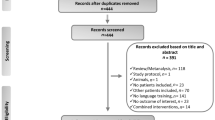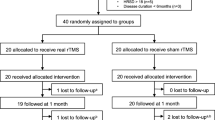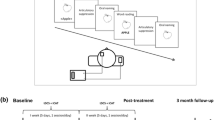Abstract
Despite considerable recent progress in understanding the underlying neurobiology of primary progressive aphasia (PPA) syndromes, relatively little attention has been directed toward the examination of behavioral interventions that may lessen the pervasive communication problems associated with PPA. In this study, we report on an individual with a behavioral profile and cortical atrophy pattern consistent with the logopenic variant of PPA. At roughly two-and-a-half years post onset, his marked lexical retrieval impairment prompted administration of a semantically based intervention to improve word retrieval. The treatment was designed to improve self-directed efforts to engage the participant’s relatively preserved semantic system in order to facilitate word retrieval. His positive response to an intensive (2-week) dose of behavioral treatment was associated with improved lexical retrieval of items within trained categories, and generalized improvement for naming of untrained items that lasted over a 6-month follow-up interval. These findings support the potential value of intensive training to achieve self-directed strategic compensation for lexical retrieval difficulties in logopenic PPA. Additional insight was gained regarding the neural regions that supported improved performance by the administration of a functional magnetic resonance imaging protocol before and after treatment. In the context of a picture-naming task, post-treatment fMRI showed increased activation of left dorsolateral prefrontal regions that have been implicated in functional imaging studies of generative naming in healthy individuals. The increased activation in these frontal regions that were not significantly atrophic in our patient (as determined by voxel-based morphometry) is consistent with the notion that neural plasticity can support compensation for specific language loss, even in the context of progressive neuronal degeneration.



Similar content being viewed by others
References
Abrahams S, Goldstein LH, Simmons A, Brammer MJ, Williams SCR, Giampietro VP, Andrew CM, Nigel Leigh P (2003) Functional magnetic resonance imaging of verbal fluency and confrontation naming using compressed image acquisition to permit overt responses. Hum Brain Mapp 20:29–40
Amici S, Gorno-Tempini M, Ogar J, Dronkers NF, Miller BL (2006) An overview on primary progressive aphasia and its variants. Behav Neurol 17:77–87
Arizona Battery for Reading and Spelling. (n.d.). Retrieved from http://web.me.com/pelagie1/Aphasia_Research_Project/Assessment_Materials.html
Ashburner J, Friston KJ (2005) Unified segmentation. NeuroImage 26(3):839–851
Beeson PM, Robey RR (2006) Evaluating single-subject treatment research: lessons learned from the aphasia literature. Neuropsychol Rev 16(4):161–169
Bier N, Macoir J, Gagnon L, van der Linden M, Louveaux S, Desrosiers J (2009) Known, lost, and recovered: efficacy of formal-semantic therapy and spaced retrieval method in a case of semantic dementia. Aphasiology 23(2):210–235
Bookheimer S, Zeffiro T, Blaxton T, Gaillard W, Theodore W (1995) Regional cerebral blood flow changes during object naming and word reading. Hum Brain Mapp 3:93–106
Borod JC, Goodglass H, Kaplan E (1980) Normative data on the Boston Diagnostic Aphasia Examination, parietal lobe battery, and the Boston Naming Test. J Clin Neuropsychol 2(3):209–215
Boyle M (2004) Semantic feature analysis treatment for anomia in two fluent aphasia syndromes. Am J Speech Lang Pathol 13(3):236, ASHA
Clare L, Jones RS (2008) Errorless learning in the rehabilitation of memory impairment: a critical review. Neuropsychol Rev 18(1):1–12
Clark DG, Charuvastra A, Miller BL, Shapira JS, Mendez MF (2005) Fluent versus nonfluent primary progressive aphasia: a comparison of clinical and functional neuroimaging features. Brain Lang 94(1):54–60
Crawford JR, Garthwaite PH, Ryan K (2011) Comparing a single case to a control sample: testing for neuropsychological deficits and dissociations in the presence of covariates. Cortex
Dale A (1999) Optimal experimental design for event-related fMRI. Hum Brain Mapp 8:109–114
Dressel K (2011) Model-oriented naming therapy in semantic dementia: a single-case fMRI study. Aphasiology 24:1–23
Fillingham JK, Hodgson C, Sage K, Lambon Ralph MA (2003) The application of errorless learning to aphasic disorders: a review of theory and practice. Psychology Press
Fillingham JK, Sage K, Lambon Ralph MA (2006) The treatment of anomia using errorless learning. Psychology Press
Folstein MF, Folstein SE, McHugh PR (1975) Mini-mental state: a practical method for grading the cognitive state of patients for the clinician. J Psychiatr Res. Elsevier Science
Frattali C (2004) An errorless learning approach to treating dysnomia in frontotemporal dementia. J Med Speech-Lang Pa 12(3):xi–xxiv, Journal of Medical Speech-Language Pathology
Fridriksson J, Morrow-Odom L, Moser D, Fridriksson A, Baylis G (2006) Neural recruitment associated with anomia treatment in aphasia. NeuroImage 32(3):1403–1412
Garrard P, Lambon-Ralph MA, Hodges JR (2002) Semantic dementia: a category-specific paradox. In: Forde E, Humphreys G (eds) Category specificity in brain and mind. Taylor & Francis, London, pp 149–176
Gold BT, Buckner RL (2002) Common prefrontal regions coactivate with dissociable posterior regions during controlled semantic and phonological tasks. Neuron 35(4):803–812
Good CD, Johnsrude IS, Ashburner J, Henson RNA, Friston KJ, Frackowiak RSJ (2001) A voxel-based morphometric study of ageing in 465 normal adult human brains. NeuroImage 14(1):21–36
Gorno-Tempini M, Dronkers N, Rankin K, Ogar J, Phengrasamy L, Rosen H, Johnson J et al (2004) Cognition and anatomy in three variants of primary progressive aphasia. Ann Neurol 55(3):335–346
Gorno-Tempini M, Ogar J, Brambati S, Wang P, Jeong JH, Rankin KP, Dronkers NF et al (2006) Anatomical correlates of early mutism in progressive nonfluent aphasia. Neurology 67:1849–1851
Gorno-Tempini M, Brambati S, Ginex V, Ogar J, Dronkers NF, Marcone A, Perani D et al (2008) The logopenic/phonological variant of primary progressive aphasia. Neurology 71:1227–1234
Gorno-Tempini ML, Hillis AE, Weintraub S, Kertesz A, Mendez M, Cappa SF, Ogar JM et al (2011) Classification of primary progressive aphasia and its variants. Neurology 76(11):1006–1014
Graham KS, Patterson K, Pratt KH, Hodges JR (1999) Relearning and subsequent forgetting of semantic category exemplars in a case of semantic dementia. Neuropsychology 13(3):359–380
Graham K, Patterson K, Pratt K, Hodges J (2001) Can repeated exposure to “forgotten” vocabulary help alleviate word-finding difficulties in semantic dementia? An illustrative case study. Neuropsychol Rehabil 11(3):429–454
Green Heredia C, Sage K, Lambon Ralph MA, Berthier ML (2009) Relearning and retention of verbal labels in a case of semantic dementia. Aphasiology 23(2):192–209
Grossman M, Mickanin J, Onishi K, Hughes E, D’Esposito M, Ding X, Alavi A et al (1996) Progressive nonfluent aphasia: language, cognitive, and PET measures contrasted with probable Alzheimer’s disease. J Cogn Neurosci 8(2):135–154
Henry ML, Gorno-Tempini ML (2010) The logopenic variant of primary progressive aphasia. Curr Opin Neurol 23(6):633–637
Henry M, Beeson P, Rapcsak SZ (2008a) Treatment for anomia in semantic dementia. Semin Speech Lang 29:60–70
Henry ML, Beeson P, Rapcsak SZ (2008b) Treatment for lexical retrieval in progressive aphasia. Aphasiology 22(7):826–838
Hodges JR, Patterson K (1996) Nonfluent progressive aphasia and semantic dementia: a comparative neuropsychological study. J Int Neuropsychol Soc 2(06):511–524, Cambridge University Press
Hodges JR, Patterson K, Oxbury S, Funnell E (1992) Semantic dementia. Progressive fluent aphasia with temporal lobe atrophy. Brain 115:1783–1806
Hodges JR, Davies RR, Xuereb JH, Casey B, Broe M, Bak TH, Kril JJ et al (2004) Clinicopathological correlates in frontotemporal dementia. Ann Neurol 56(3):399–406
Howard D, Patterson KE (1992) The Pyramids and Palm Trees Test: a test of semantic access from pictures and words. Thames Valley Test Company, Bury St. Edmunds, Suffolk
Jokel R, Rochon E, Leonard C (2006) Treating anomia in semantic dementia: improvement, maintenance, or both. Neuropsychol Rehabil 16(3):241–256
Jokel R, Cupit J, Rochon E, Graham N (2007) Errorless re-training in semantic dementia using MossTalk Words. Brain Lang 103(1–2):205–206
Jokel R, Cupit J, Rochon E, Leonard C (2009) Relearning lost vocabulary in nonfluent progressive aphasia with MossTalk words. Aphasiology 23:175–191
Jokel R, Rochon E, Anderson N (2010) Errorless learning of computer-generated words in a patient with semantic dementia. Neuropsychol Rehabil 20(1):16–41
Josephs KA, Duffy J, Strand E, Whitwell J, Layton K, Parisi J, Hauser M et al (2006) Clinicopathological and imaging correlates of progressive aphasia and apraxia of speech. Brain 129(6):1385–1398
Kang HJ, Baik Y, Go SA, Kim JE, Park KD, Choi KG, Jeong JH (2010) Anatomical correlates of primary progressive aphasia subtypes using SPGR 3D volumetric analysis. Alzheimer’s & Dementia. The Alzheimer’s Association
Kaplan E, Goodglass H, Weintraub S (2001) Boston Naming Test: record booklet. Lippincott Williams & Wilkins, Philadelphia
Kaufer D, Cummings J, Ketchel P, Smith V, MacMillan A, Shelley T, Lopez O et al (2000) Validation of the NPI-Q, a brief clinical form of the Neuropsychiatric Inventory. J Neuropsychiatry Clin Neurosci 12:233–239
Kay J, Lesser R, Coltheart M (1992) PALPA: Psycholinguistic Assessments of Language Processing in Aphasia. Lawrence Erlbaum Associates, East Sussex
Kertesz A (1982) Western aphasia battery test manual. The Psychological Corporation, San Antonio
Kertesz A (2005) The evolution and pathology of frontotemporal dementia. Brain 128(9):1996–2005
Lawton M, Brody E (1969) Assessment of older people: self-maintaining and instrumental activities of daily living. Gerontologist 9:179–186
Lowell S, Beeson PM, Holland A (1995) The efficacy of a semantic cueing procedure on naming performance of adults with aphasia. Am J Speech Lang Pathol 4:109–114
Marcotte K, Ansaldo A (2010) The neural correlates of semantic feature analysis in chronic aphasia: discordant patterns according to the etiology. Semin Speech Lang 31(1):52–63
McNeil M, Small S, Masterson R, Fossett T (1995) Behavioral and pharmacological treatment of lexical-semantic deficits in a single patient with primary progressive aphasia. Am J Speech Lang Pathol 4:76–87
Meinzer M, Flaisch T, Wilser L, Eulitz C, Rockstroh B, Conway T, Gonzalez-Rothi L et al (2009) Neural signatures of semantic and phonemic fluency in young and old adults. MIT, Cambridge
Mesulam M-M, Grossman M, Hillis A, Kertesz A, Weintraub S (2003) The core and halo of primary progressive aphasia and semantic dementia. Ann Neurol 47:1329–1335
Mesulam M, Wicklund A, Johnson N, Rogalski E, Léger GC, Rademaker A, Weintraub S et al (2008) Alzheimer and frontotemporal pathology in subsets of primary progressive aphasia. Ann Neurol 63(6):709–719
Mummery C, Patterson K, Price C, Ashburner J, Frackowiak R, Hodges J (2000) A voxel-based morphometry study of semantic dementia: relationship between temporal lobe atrophy and semantic memory. Ann Neurol 47:36–45
Murray L (1998) Longitudinal treatment of primary progressive aphasia: a case study. Aphasiology 12(7/8):651–672
Neary D, Snowden J, Gustafson L, Passant U, Stuss D, Black S, Freedman M et al (1998) Frontotemporal lobar degeneration: a consensus on clinical diagnostic criteria. Neurology 51(6):1546–1554
Nestor P, Balan K, Cheow H, Fryer T (2007) Nuclear imaging can predict pathologic diagnosis in progressive nonfluent aphasia. Neurology 68(3):238–239
Newhart M, Davis C, Kannan V, Heidler-Gary J, Cloutman L, Hillis A (2009) Therapy for naming deficits in two variants of primary progressive aphasia. Aphasiology 23(7):823–834
Nicholas L, Brookshire RH (1993) A system for quantifying the informativeness and efficiency of the connected speech of adults with aphasia. J Speech Hear Res 36:338–350
Nichols T, Hayasaka S (2003) Controlling the familywise error rate in functional neuroimaging: a comparative review. Stat Methods Med Res 12(5):419–446
Perani D (2003) A fMRI study of word retrieval in aphasia. Brain Lang 85(3):357–368
Price CJ, Devlin JT, Moore CJ, Morton C, Laird AR (2005) Meta-analyses of object naming: effect of baseline. Hum Brain Mapp 25(1):70–82
Rabinovici GD, Jagust WJ, Furst AJ, Ogar JM, Racine CA, Mormino EC, O’Neil JP et al (2008) Aβ amyloid and glucose metabolism in three variants of primary progressive aphasia. Ann Neurol 64(4):388–401
Raven JC, Court JH, Raven JE (1990) Coloured progressive matrices: sets A, AB, B. Oxford Psychologists, Great Britain
Reitan RM, Wolfson D (1985) The Halstead–Reitan Neuropsychological Test Battery: therapy and clinical interpretation. Neuropsychological, Tucson
Roach A, Schwartz MF, Martin N, Grewal RS, Brecher A (1996) The Philadelphia naming test: scoring and rationale. Clin Aphasiol 24:121–133
Rossion B, Pourtois G (2004) Revisiting Snodgrass and Vanderwart’s object pictorial set: the role of surface detail in basic-level object recognition. Perception 33(217):236
Sapolsky D, Domoto-Reilly K, Negreira A, Brickhouse M, McGinnis S, Dickerson B (2011) Monitoring progression of primary progressive aphasia: current approaches and future directions. Neurodegener Dis Manag
Schneider SL, Thompson CK, Luring B (1996) Effects of verbal plus gestural matrix training on sentence production in a patient with primary progressive aphasia. Aphasiology 10(3):297–317
Snowden J, Neary D (2002) Relearning of verbal labels in semantic dementia. Neuropsychologia 40(10):1715–1728
Taylor C, Kingma RM, Croot K, Nickels L (2009) Speech pathology services for primary progressive aphasia: exploring an emerging area of practice. Aphasiology 23(2):161–174
Tombaugh T (2004) Trail Making Test A and B: normative data stratified by age and education. Arch Clin Neuropsychol 19(2):203–214
Tombaugh T, Kozak J, Rees L (1999) Normative data stratified by age and education for two measures of verbal fluency: FAS and animal naming. Arch Clin Neuropsychol 14(2):167–177
Warburton E, Wise RJS, Price CJ, Weiller C, Hadar U, Ramsay S, Frackowiak RSJ (1996) Noun and verb retrieval by normal subjects. Studies with PET. Brain 119(1):159–179
Warrington E (1975) The selective impairment of semantic memory. Q J Exp Psychol 27:635–657
Wechsler D (1984) WMS-R: Wechsler Memory Scale—Revised: manual. The Psychological Corporation, San Antonio
Wierenga CE, Benjamin M, Gopinath K, Perlstein WM, Leonard CM, Rothi LJG, Conway T et al (2008) Age-related changes in word retrieval: role of bilateral frontal and subcortical networks. Neurobiol Aging 29(3):436–451
Wilson BA, Baddeley A, Evans J, Shiel A (1994) Errorless learning in the rehabilitation of memory impaired people. Neuropsychol Rehabil 4(3):307–326
Acknowledgments
This work was supported by grants R01 DC007646 (PMB), R01 DC008286 (SZR), and F31DC009145 (MLH) from the National Institute on Deafness and Other Communication Disorders. The authors thank Sarah Andersen and Kindle Rising for their assistance with this paper.
Author information
Authors and Affiliations
Corresponding author
Rights and permissions
About this article
Cite this article
Beeson, P.M., King, R.M., Bonakdarpour, B. et al. Positive Effects of Language Treatment for the Logopenic Variant of Primary Progressive Aphasia. J Mol Neurosci 45, 724–736 (2011). https://doi.org/10.1007/s12031-011-9579-2
Received:
Accepted:
Published:
Issue Date:
DOI: https://doi.org/10.1007/s12031-011-9579-2




